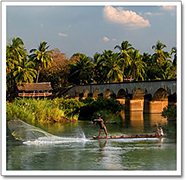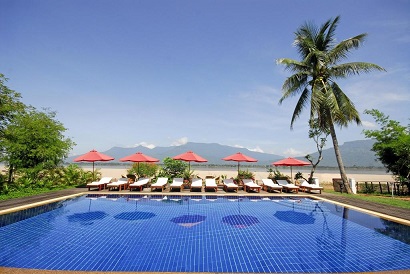It’s often true that the outer reaches of any country are the most beautiful and least developed, and in Laos you’ll find this in spades.
Head to the extreme south and the Mekong River breaks down into a myriad of arms and channels that surround tiny islands, sandbars and islets to create a water world, home to rare flora and fauna including the freshwater dolphin.
Si Phan Don - Home Of 4,000 Islands...
 In Lao "Si Phan Don" means "4000 islands" which may be pushing it, but there’s no doubt that the south of Laos will become increasingly popular as holidaymakers are drawn by the wild and remote region’s natural beauty, pace of life and the chance to enter a rural idyll little changed over the last 100 years.
In Lao "Si Phan Don" means "4000 islands" which may be pushing it, but there’s no doubt that the south of Laos will become increasingly popular as holidaymakers are drawn by the wild and remote region’s natural beauty, pace of life and the chance to enter a rural idyll little changed over the last 100 years.
During the rainy season this section of the Mekong fills out to a breadth of 14km, the river’s widest reach along its 4350km journey from the Tibetan Plateau to the South China Sea.
Experience Si Phan Don by boat or Island Stay
With so much water it’s no surprise that experiencing it by boat is so popular and one of the most comfortable is aboard the converted former teak wood ferry boat, the Vat Phou,  on a 3 day / 2 night cruise.
on a 3 day / 2 night cruise.
Alternatively you can travel by car and stay on one of the many islands to enjoy an extended experience of rural Mekong life. The choice of hotels has improved marketedly over the last few years and some are worth including as a relaxing end to your holiday.
As the islands are small and flat you can easily explore by bike or on foot past farms and fishing villages, learn to fish and kayak, keeping an eye out for the rare Irrawaddy dolphin.
Khone Falls and Pha Pheng - The Largest Waterfalls in SE Asia
Don Khone and Don Det are two of the main islands linked by a beautiful bridge built by the French and close to the Cambodia border. Don Khone also has remnants of an old steam engine which is left over from when the French built the only railroad in Laos. The French had hoped to navigate the length of the Mekong but the Khone and Pha Pheng waterfalls that form the border with Cambodia and separate the upper Mekong from the lower Mekong, completely seal off the two sections with a rolling mass of rapids and falls that stretch over a kilometre and drop around 30 metres. As the largest waterfalls in southeast Asia they are worth a visit.
From here you can either head back north to Pakse or continue by land into Cambodia to explore the wild north and onto Angkor.

